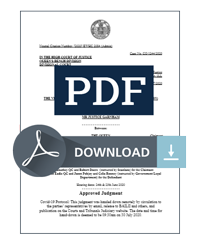JOINT ENTERPRISE HOMICIDE, INFERENCES AND SOLUTIONS
By Dr Felicity Gerry QC
As the Law Commission of England and Wales announces a review into the appeals system, Dr Felicity Gerry QC considers the wider problems in joint enterprise homicide that feed into the restrictive appellate process and she offers some potential solutions.
Whatever the media click bait on joint enterprise, multi defendant trials and appeals are largely conducted by a profession and judiciary lacking in diversity, so we need to consider whether the system is failing people of colour and what inferences are being drawn due to bias. In 2022, three cases highlight the current enthusiasm for prosecutors to rely on an allegation of a “plan” and the potential injustices that may achieve both at trial and on appeal:
Conviction of young people (particularly those of colour) based on being complicit in someone else’s crime leads to a mandatory life sentence in England and Wales. The prisons are rapidly filling up with youths who commit robbery or violent disorder but someone who they are with kills during those crimes, and they are found to be equally responsible. As alleged secondary parties, they are no real risk to the public. They are often people of colour and/or with cognitive disabilities. The Court of Appeal will not entertain any challenge to incorrect legal directions – accepting a broad range of errors. Cases turn on the prosecution case theories, not on the potential truth. The past 25 years of searching for factual tests mean that, whilst the test for men’s rea was corrected in Jogee, the conduct element is now so low that people are convicted of serious crime for moral or minimal assistance or encouragement and face the maximum penalty. What this means is that the prisons are filling up with people who did NOT kill and largely it depends on whether the jury believe them or not – being “sure” that someone is party to a plan is ultimately turning on credit, not fact or law. In Jogee one ground of appeal was that joint enterprise “over-criminalises secondary parties”. That ground has still not been answered.
In April 2022 Ryan Graham (a young black man) was convicted of murder after a trial at the Old Bailey. The prosecution case was that he and two others planned to sell a kilo of cannabis to the deceased and that a plan was hatched, at some unspecified stage, to rob the deceased, rather than supply the goods. The trial judge accepted that there was insufficient evidence to say the alleged plan was hatched in their car on the way to the meeting place and acquitted the driver, who was later acquitted by the jury of assisting the offenders by driving them away after the killing. The prosecution relied on CCTV and witness evidence against the three remaining defendants, including Ryan Graham, to infer that the use of knives would be part of the alleged “plan” to rob. There was clear evidence that two co-accused were in possession of knives. The trial judge concluded on sentence that he could not be sure that Ryan Graham had a knife which means Ryan Graham was NOT a killer but sentenced as a secondary party. Witness evidence was that Ryan Graham was searching the deceased’s pockets whilst one co-accused held the deceased in a headlock (also with a knife taken out from up his sleeve) and another was chasing the deceased’s brother with a knife that he had secreted down his trousers. Ryan Graham gave evidence that he was not searching pockets, the attack was a surprise to him, and he was trying to stop it. He accepted running from the scene. There was evidence he had blood on his clothing which put him close to the killing. Accordingly, it was his case that there was no plan or if the others had a plan, he was not a party to it. He gave evidence denying participating in murder. He wrote to the police telling them where his co-accused had disposed of the knife, and he had supportive character references that he was a gentle and kind individual with some cognitive limitations. He was not believed. He was sentenced to a mandatory life sentence with a minimum term of 27 years. This means he has a life sentence for the murder of someone he did NOT kill. It also means that the question of whether there was a plan or not effectively turned on whether the jury believed the prosecution case theory or the accused person. It is not exactly a sound basis for a conviction but in the current climate, it seems to be the basis for the criminal law.
There are partial results which also expose problems: In July 2022 Adam Qayum (a young Asian man) was found not guilty of murder after a trial in Bradford. The prosecution case was that one of his friends was attacked in Bradford town centre and Adam Qayum returned with five others to exact revenge. The evidence from independent witnesses was that they returned to collect a mobile telephone and three took knives to scare the attackers if they reappeared. Two defendants waved knives and one killed the deceased and seriously wounded another youth. He suffered from mental health issues. The three with knives were convicted. The first of murder, on the basis that he was the principal offender. The other two with knives of manslaughter, on the basis that they assisted or encouraged him to harm, despite them giving evidence that this was not true and CCTV evidence that they did not harm anyone. The other three were acquitted. Despite it being literally visible on CCTV that Adam Qayum did not join in, the prosecution still sought to allege this was a joint plan and, even though the jury acquitted three defendants, which tends to suggest there was no plan, the trial judge sentenced based on a revenge attack. Adam Qayum and the other two acquitted gave evidence and were either believed or at least the jury could not be sure that the prosecution case theory was correct. Those convicted, including the two who did NOT kill, all face life imprisonment with long minimum terms and the judicial sentencing remarks forever records the events as a revenge attack, even though the jury may well have rejected that scenario. Despite two eminent experts agreeing that the principal offender was suffering a psychosis at the time, the judge sentenced on the basis that he was lying about its effects at the time – again credit being at the forefront of decision making. The others did not or could not have known about his mental health issues and yet were convicted which means they were not believed. Is this really a search for evidence or a punishment for lying? Without reasons from a jury, we will never know.
Also in July 2022, the Court of Appeal rejected an application for leave to appeal by T’Shai Ennis (a young black man) Reported at [2022] EWCA Crim 1088. He was in a car, not at the scene when someone was killed in 2015. His jury did not know he had a cognitive disability so could not evaluate whether he could assess what others would do. Rap music was used against him. Adverse inferences were drawn from his silence in police questioning, even though it is known that silence is driven by distrust of the police and prosecution. The prosecution agreed that his jury were not directed on parasitic accessorial liability (which was expunged in Jogee) but nonetheless the trial judge used foresight as a test for men’s rea and directed the jury that there was a premeditated plan – the very question the jury were supposed to answer. Thus, the jury were misdirected on in both fact and law and were not fully informed about T’Shai’s cognitive limitations and were not told of the burgeoning evidence that race plays in inferences being drawn adversely against young black people. His application for leave to appeal being refused means the Supreme Court is ‘functus’. In these types of appeals, evidence is emerging that there has been a huge drop in leave / grants since 1998 and even where the ‘substantial injustice’ test does not apply, the Court of Appeal will not accept a conviction is unsafe. These should be serious statistics for the Law Commission to consider.
The ultimate issue of guilt is therefore not turning on complicity law but on inferences sought to be drawn by prosecutors, confirmation of those inferences by judges and significant weight being placed on credit. To what extent this includes confirmation bias is not known. Some in the judiciary might say that they are stuck with CPS decisions to charge murder when alternatives of violent disorder or robbery are available. Others in the judiciary might silently agree that mandatory sentencing is brutal, and they would prefer a discretion to sentence secondary parties more consistently. Ultimately it is unlikely they will say so. The Court of Appeal may be working on the basis that finality takes precedence over safety – the accuracy of this will hopefully be revealed by the Law Commission Review.
In the meantime, what are the remedies?
- The first step is to read the research by Hulley and Young on adverse inferences that demonstrates joint enterprise lacks legitimacy amongst prisoners. To view our webinar on this issue click here
- Next is to audit the police for conduct in questioning suspects of colour and bias in the collation of evidence and character, particularly alleged ‘gang’ databases and how music is disproportionality used against people of colour. To view our webinar on the rap music issue click here
- Other remedies may well be revealed by an audit of the CPS decision making on charges, including the prosecutorial formulation of case theories and how equitable briefing is managed to ensure diversity of expertise. This was last attempted pre-Jogee by Birkbeck in a project in which Dr Gerry QC was involved – read here:
- Ultimately, Dr Gerry QC has long called for an audit of prisons to see who is in there but was NOT a killer – an issue now picked up by the campaign group JENGbA and apparently of interest to David Lammy MP whose ground breaking report on race and criminal justice can be read here.
- The swiftest remedy is to (a) abolish mandatory sentencing and (b) grant pardons to reduce sentences for those already convicted. See Dr Gerry’s article on this in the Australian context here
Ultimately developing the law to ensure we have a Court of Appeal that is keener to grant retrials where race and disability are issues for juries to consider will depend on how robust the Law Commission Review is on such issues. We shall have to wait and see – In the meantime, to see Dr Gerry’s article on race and joint enterprise click here
Dr Gerry QC acted for the defence for Ryan Graham leading Marie Spenwyn of Libertas Chambers, instructed by Pillai and Jones Solicitors.
Dr Gerry QC acted for the defence of Adam Qayum, leading Sanjeev Sharma of Equity Chambers, instructed by Ali and Co Solicitors.
Dr Gerry QC acted for T’Shai Ennis on appeal, but not at trial, instructed by GT Stewart Solicitors.


